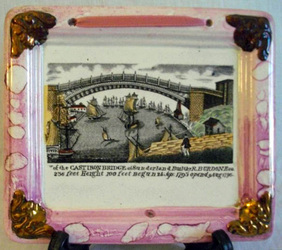|
In my January 9th blog post, I said it didn't seem logical that Scott of Southwick would have commissioned two sets of transfer plates (Prepare... Thou... & Praise...) – one with 'In the O Lord...' and the other with 'In thee O Lord' in the verse above the trumpeting angel. We know that transfer plates were valuable, because they were sold on after potteries closed, and carefully restored by flattening out and re-engraving. So why would one pottery go to the expense of producing two sets of almost identical transfer plates, and use them simultaneously on different wares? And yet, both sets of transfers have strong links to Scott. Below are the plaque forms with 'the' in the verse. The Wesley transfer, particular to Scott (or Southwick), appears on all of these plaque forms. The next group of plaques all have 'thee' in the verse. They are attributed to Scott on the basis that transfers of ships etc on brown-bordered plaques, like the one below right, also appear on plates and bowls with the 'SCOTT' impress. The next three plaques show that it isn't just religious verses that link these three plaque forms. The left plaque below has white edges showing from the front, like the one above it. The centre plaques, above and below, are of a smaller, plainer rectangular form. The right plaques, above and below, are the large brown-bordered plaques most commonly attributed to Scott. The Mariner's Compass also appears on all these three plaque forms. But are there any transfers that link the 'the' group with the 'thee' group of plaques? Take a look below. The plaque on the left is of the type with white edges showing from the front, and belongs to the 'thee' group of plaque forms. The plaque on the right belongs to the 'the' group. Likewise, the brown-bordered plaque below belongs to the 'thee' group, and the orange plaque with rounded corners to the 'the' group. So if all the above plaques are Scott, why would he have commissioned two sets of verse transfers, one with 'the' and one with 'thee'? And why weren't they both used on all of the Scott-attributed plaque forms? These questions might be linked to perhaps the greatest plaque mystery of all: why are there so many transfers which commonly appear on jugs and bowls but never on plaques? Scott's Southwick Pottery was large, with 152 workers (in 1861) spread over a sprawling site of inter-connecting buildings (see Baker, fig 48, p49). What if different areas were set up for producing different lines of pottery? Jugs and bowls in one place, plates and plaques in another. Perhaps one set of plaque moulds were kept in one area, and another set somewhere else. If transfers were printed close to where the enamels were fired, transfer plates might have been location-specific too.
'Prepare to meet thy god', 'Thou god seest me' and 'Praise ye the lord', were the most popular plaques. Maling produced 'Prepares' and 'Thous' from 1817, and they were still in production at Ball's Deptford Pottery at the turn of the 20th century. So economically speaking, it might have made perfect sense to have two sets of transfer plates for use at different ends of the pottery. It would have doubled Scott's capacity to produce his best-selling plaques. So perhaps not so illogical after all. I'm under no illusions regarding the number of 'what ifs' in my reasoning above. As always, I'd love to be told how and why I've got it wrong (though being told I'd got it right would obviously be better!).
0 Comments
Leave a Reply. |
AuthorStephen Smith lives in London, and is always happy to hear from other collectors. If you have an interesting collection of plaques, and are based in the UK, he will photograph them for you. Free advice given regarding selling and dispersal of a collection, or to those wishing to start one. Just get in touch... Archives
February 2022
AcknowledgementsThis website is indebted to collectors, dealers and enthusiasts who have shared their knowledge or photos. In particular: Ian Holmes, Stephen Duckworth, Dick Henrywood, Norman Lowe, Keith Lovell, Donald H Ryan, Harold Crowder, Jack and Joyce Cockerill, Myrna Schkolne, Elinor Penna, Ian Sharp, Shauna Gregg at the Sunderland Museum, Keith Bell, Martyn Edgell, and Liz Denton.
|












